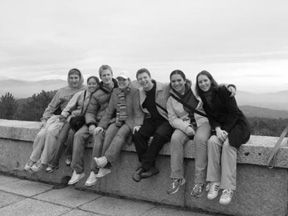By Maya Minwary
Staff Correspondent
LONDON—Sitting down at a quaint little restaurant for lunch in Segovia, Spain, the London group saw a man dressed up in a suit wearing medallions while a couple of waiters rolled out six or seven whole little roasted piglets on a tray. The man in the suit started to read out of a black folder in Spanish and suddenly we hear “whack” and the man is chopping the roasted piglets with a plate. As he finished this ceremony he threw the plate down in the floor, shattering it to pieces. Our mouths gaped open as the man nonchalantly walked off, as if the meal we were about to eat was a normal everyday feast for the Spanish.
 While the most fascinating part about our educational field trip to Spain should have been about El Greco, Velasquez or Goya’s beautiful artworks in the Prado Museum in Madrid or the beautiful sight on top of the Valley of the Fallen, a lot of us will never forget what I would like to call a very interesting and violent lunch. Moreover, as if watching the butchering of piglets wasn’t bad enough, some of us received interesting body parts, such as the hoof and tail of the animal as part of our meal (eek). I guess that would explain the many vegetarian converts that day.
While the most fascinating part about our educational field trip to Spain should have been about El Greco, Velasquez or Goya’s beautiful artworks in the Prado Museum in Madrid or the beautiful sight on top of the Valley of the Fallen, a lot of us will never forget what I would like to call a very interesting and violent lunch. Moreover, as if watching the butchering of piglets wasn’t bad enough, some of us received interesting body parts, such as the hoof and tail of the animal as part of our meal (eek). I guess that would explain the many vegetarian converts that day.
But in Segovia, this was a traditional meal. While some students were very disturbed, for the most part, we all got over it, especially after being exposed to more facets of the Spanish culture.
Our days were filled with intense educational travels in Madrid and surrounding cities Segovia, El Escorial, The Valley of the Fallen and Toledo. We learned facts about this building and that cathedral, while trying to stay awake and recover from our late nights out in the city. Although it might have seemed like we were exasperated from our lack of sleep and hours of traveling each day, most of us were impressed by each sight we saw and each city we visited. Even when we were in The Valley of the Fallen, which is essentially not even a city, but a monastery, we were taken aback by its beautiful rustic  surrounding up high in the mountains. Personally, I was amazed at how much I appreciated the history lesson. It made me see how rich the Spanish culture is. It wasn’t just about flamenco dancing or bull fighting, but it was like each wall and each artwork had a story to it.
surrounding up high in the mountains. Personally, I was amazed at how much I appreciated the history lesson. It made me see how rich the Spanish culture is. It wasn’t just about flamenco dancing or bull fighting, but it was like each wall and each artwork had a story to it.
The city of Toledo is a great example of how rich in culture Spain is. Once ruled by the Moors, Toledo has some of the most beautiful architecture in Europe. The city has been influenced by the Moors, but also from the early Catholics and Jews. There’s even a former Jewish Temple that was built with the architecture keyhole design of the Moors. It was cool to know that these three very different cultures and religions once lived in Spain peacefully.
Spain left me and many other Londoners a great memory. It’s funny how before I visited the country I had no incentive what-so-ever to learn the language. I took French in high school and was very stubborn to keep my study of that language. But after realizing how much I love Spain and want to go back (as well as realizing how frustrating it is to be in a country where you don’t understand the language at all), I think my opinions have changed. So I’m still not a big fan of chopping up little piglets with a plate, but I have a new appreciation for the Spanish language and culture.
March 20, 2003

